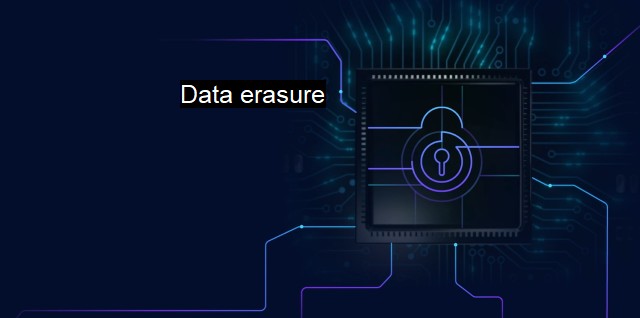What is Data erasure?
Protecting Confidential Data: An Exploration of Data Erasure Methods and Their Importance in Cybersecurity
Data erasure, also known as data clearance or data wiping, is a software-based method of securely overwriting data from any storage device that uses assorted methodologies with the fundamental aim of wiping the data completely and irretrievably. It is an essential practice often used in the field of cybersecurity and antivirus applications, thereby rendering the data inaccessible to those without the right tools or authorization. The overarching purpose of data erasure is to keep sensitive information—such as official records, financial data, proprietary research, among others—secure and prevent unauthorized access or misuse.Data, when simply deleted or reformatted, is not completely wiped off a device. The information remains present and can be easily recovered, albeit with the necessary technical acumen or software. This revelation presents an imminent cyber risk, especially when devices are sold, repurposed, or sent in for repair. In such situations, data erasure proves instrumental in offering relief from the anxiety of potential data misappropriations – both intentional and accidental.
The function of data erasure in the context of cybersecurity is invaluable. It plays a significant role in mitigating the risk of data theft while maintaining compliance with several regulations like the GDPR (General Data Protection Regulation) and HIPAA (Health Insurance Portability and Accountability Act), which mandate certain standards requiring complete destruction of data when devices are decommissioned.
Data erasure prevents unauthorized data exposure preventively rather than reactively. For instance, an antivirus software identifies and neutralizes external threats that might compromise data integrity. Simultaneously, data erasure ensures even if the data becomes extraneous, redundant, or the device falls into the wrong hands, the data is preserved in its secure state, rendering itself unusable to intruders or unauthorized users.
Data erasure is not a monolith; instead, it resides on a spectrum of complexity and sophistication. Ranging from cryptographic erasure, which encrypts data making it unreadable without the cryptographic key, to simple software erasure, where data is overwritten with different patterns of ‘0s’ and ‘1s’, based on chosen algorithms ultimately designed to prevent recovery.
Contemporary data erasure methods are particularly comprehensive, safeguarding against emerging and sophisticated threats that loom over the cyber landscape. Erasure verification using digital reports certifying successful data erasure is a standard practice, adding another tier of security. Authorized users or organizations can access these digital reports fulfilling accountability requirements laid down by cyber laws or organizational policies.
With the booming growth in sectors of cloud computing and Big Data, data erasure’s role becomes even more pivotal. So much so, leading data erasure solutions offer compatibility with a variety of devices and systems, including some specifically built for erasing data from cloud storage.
Considering the persistent and evolving nature of cyber threats, data erasure has found its imperative place in cybersecurity measures and antivirus applications. Complementing the reactive nature of antivirus software, data erasure secures an exclusive spot in pre-emptive security measures. not all antivirus solutions include the function of data erasure, emphasizing the need for the inclusion of software designed particularly for data erasure.
Data erasure is not a magic wand and cannot replace the broad range of cybersecurity practices required by organizations. Applying a cybersecurity strategy based on a risk management approach will be much more effective, where data erasure happens to be one principled component amongst many. New hardware or software configurations, network access controls, or data security training for employees must take center stage coupled with data erasure.
Data erasure empowers strong cybersecurity by discouraging data theft and unauthorized access to redundant, discarded or sensitive information. Albeit a strategically used cybersecurity tool, and not a standalone solution, data erasure is a good practice that complements other cybersecurity and antivirus efforts. By ensuring that old files and data can be irretrievably destroyed, data erasure contributes to the safety net, sustainably protecting against cyber threats.

Data erasure FAQs
What is data erasure in cybersecurity?
Data erasure in cybersecurity is the process of securely and permanently removing data from hardware devices such as hard drives, smartphones, and computers to prevent unauthorized access to sensitive information.Why is data erasure important in antivirus software?
Data erasure is crucial in antivirus software because it ensures that malware or viruses that have infected a device are completely removed. This prevents the malware from remaining on the device and potentially compromising sensitive information.What methods are commonly used for data erasure?
Common methods used for data erasure include overwriting the data with random patterns, physically destroying the storage media, and using software tools designed specifically for data erasure.Can data ever be truly erased?
While data erasure methods can make it extremely difficult to recover data, it can never be completely guaranteed that all data has been fully erased. However, by following best practices for data erasure such as using multiple methods and verifying erasure completion, the risk of data recovery can be greatly minimized.| | A | | | B | | | C | | | D | | | E | | | F | | | G | | | H | | | I | | | J | | | K | | | L | | | M | |
| | N | | | O | | | P | | | Q | | | R | | | S | | | T | | | U | | | V | | | W | | | X | | | Y | | | Z | |
| | 1 | | | 2 | | | 3 | | | 4 | | | 7 | | | 8 | | |||||||